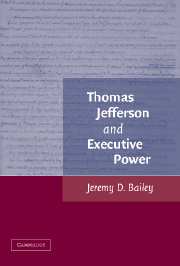Book contents
- Frontmatter
- Contents
- List of Figures and Table
- Preface
- Acknowledgments
- Abbreviations
- 1 “The execution of laws is more important than the making of them”: Reconciling Executive Power with Democracy
- 2 Executive Power and the Virginia Executive
- 3 Executive Power and the Constitution of 1787
- 4 “To place before mankind the common sense of the subject”: Declarations of Principle
- 5 The Real Revolution of 1800: Jefferson's Transformation of the Inaugural Address
- 6 To “produce a union of the powers of the whole”: Jefferson's Transformation of the Appointment and Removal Powers
- 7 The Louisiana Purchase
- 8 To “complete their entire union of opinion”: The Twelfth Amendment as Amendment to End All Amendments
- 9 “To bring their wills to a point of union and effect”: Declarations and Presidential Speech
- Development and Difficulties
- Index
6 - To “produce a union of the powers of the whole”: Jefferson's Transformation of the Appointment and Removal Powers
Published online by Cambridge University Press: 24 July 2009
- Frontmatter
- Contents
- List of Figures and Table
- Preface
- Acknowledgments
- Abbreviations
- 1 “The execution of laws is more important than the making of them”: Reconciling Executive Power with Democracy
- 2 Executive Power and the Virginia Executive
- 3 Executive Power and the Constitution of 1787
- 4 “To place before mankind the common sense of the subject”: Declarations of Principle
- 5 The Real Revolution of 1800: Jefferson's Transformation of the Inaugural Address
- 6 To “produce a union of the powers of the whole”: Jefferson's Transformation of the Appointment and Removal Powers
- 7 The Louisiana Purchase
- 8 To “complete their entire union of opinion”: The Twelfth Amendment as Amendment to End All Amendments
- 9 “To bring their wills to a point of union and effect”: Declarations and Presidential Speech
- Development and Difficulties
- Index
Summary
Jefferson described his election as a revolution, but his First Inaugural showed that elections, in place of revolutions, would provide the means for determining the majority will. More than any of his contemporaries, Jefferson perceived that the president would come to embody the majority by way of the presidential election. Thus Jefferson advocated a term limit for presidents in order to maximize the opportunities for presidents to lead constitutional majorities. And thus Jefferson invented the inaugural address as a practical means by which the principles of constitutional majorities may be enunciated.
The first test of Jefferson's declaration of principles was the appointment and removal powers. Because 1800 was the first transfer of power, the meaning of that election would most immediately turn on the way Jefferson distributed executive offices. Scholars have long recognized that Jefferson should share some of the credit, normally reserved for Andrew Jackson, for inventing the spoils system, in which the victorious party distributes offices to its members. By refusing to acknowledge John Adams's “midnight appointments,” eliminating offices in the military and judiciary, forcing resignations, removing those who would not resign, and by appointing fellow partisans to theses offices, Jefferson brought the Revolution of 1800 to the bureaucracy. Again, instead of shunning executive power, Jefferson embraced it.
What scholars have not appreciated fully enough, however, is the extent to which Jefferson's argument for the removal power was based on his plan for executive power.
- Type
- Chapter
- Information
- Thomas Jefferson and Executive Power , pp. 151 - 170Publisher: Cambridge University PressPrint publication year: 2007



